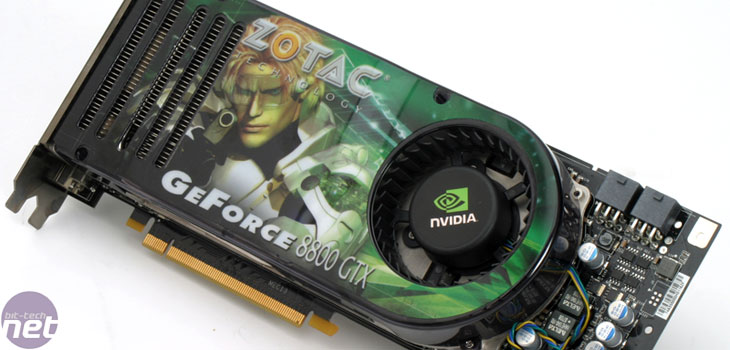Overclocking:
We used the latest version of RivaTuner for our Zotac GeForce 8800 GTX AMP! Edition overclocking endeavours and unfortunately we didn’t get very far. In fact, it was very similar to what we’ve experienced with other factory overclocked GeForce 8800 GTXs.The first change we made was to increase the core clock by 10MHz from 630MHz to 640MHz and we then ran a couple of games immediately noticing a checkerboard effect in all of them – a sign that the core was unstable at these clocks. We finally got the core stable at 634MHz – that’s a measly 4MHz increase in clock speed.
We then went and pushed the memory clock. Being the ambitious guy that I am, I headed straight for 2200MHz and as soon as I loaded an Oblivion save game, BAM! It hard locked.
2100MHz was next and even at this speed I experienced tearing although there was no hard locking this time around – stable but not pretty, I guess. I then kept lowering the memory clock until I saw no visible tearing after 30 minutes of gameplay and ended up down at 2070MHz. Still, that's another 3.5 percent increase in memory clock over the reference clock speeds, resulting in a 14.5 percent increase over the GeForce 8800 GTX's standard speeds.
I ran a quick and dirty Oblivion benchmark at 2560x1600 2xAA 16xAF and saw frame rates of 31.1 average and 21 minimum. That's a measly 0.5 frames per second increase in average frame rate and no increase in minimum frame rate over the AMP! Edition's standard clock speeds.

Conclusions:
On the whole, Zotac's first foray into our labs has been a pretty good one. Of course there is very little differentiation, aside from clockspeeds, from most other board partners out there because Nvidia’s high-end cards are all built by a third party contractor. However, what we have seen is that even a relatively new manufacturer can polish Nvidia’s now nine month old GeForce 8800 GTX and create a pretty good product.We’re a little disappointed that Zotac didn’t increase the shader clock speed, but considering the relatively small performance difference this isn’t a massive issue. Games are becoming more shader heavy and as proven by the GeForce 8800 Ultra, the higher shader clock results in ultimately higher performance even despite a lower “core” clock.
I think that trend is only going to continue going forwards as more and more shader heavy games come out. DirectX 10 is all about shaders and doing more with pixels instead of necessarily rendering more pixels on the screen at any given time, so higher clocks on the shader portion of this graphics card would have made sense in our eyes.
Zotac has positioned this card quite aggressively if the likes of Ebuyer and CCL Computers can sell at, or under the £389.99 suggested retail price given to us by Zotac’s sales representatives. EVGA’s e-GeForce 8800 GTX KO Superclocked ACS³ card retails for around £415 (inc. VAT), while other cards like the XFX GeForce 8800 GTX XXX Edition (which has the same clock speeds as Zotac’s AMP! Edition) retail for around £410 (inc. VAT).
Probably the closest competition on price is BFGTech’s GeForce 8800 GTX OC2 video card, which is currently on pre-order at Scan for just under £400 (inc. VAT). BFGTech’s card currently has a better warranty than Zotac, but as we mentioned towards the start of the review, we’ve heard rumours suggesting that Zotac might be looking to extend its warranty to something comparable to what both BFGTech and EVGA offer in Europe. If that happens, then all of a sudden Zotac’s GeForce 8800 GTX AMP! Edition card looks very competitive.
Final Thoughts...
Zotac’s GeForce 8800 GTX AMP! Edition is a good card with a pretty good bundle and a competitive price (subject to final retail pricing). We would have liked to see Zotac increase the stream processor clock speed, but even without those increases it stands up to the competition pretty well. The only thing really missing from the product at the moment is an extended warranty if that matters to you, but from the rumours we’ve heard, the wheels for that are already in motion – we’ll be sure to keep you updated on those developments.- Features
- x
- x
- x
- x
- x
- x
- x
- x
- x
- -
- 9/10
- Performance
- x
- x
- x
- x
- x
- x
- x
- x
- x
- -
- 9/10
- Value
- x
- x
- x
- x
- x
- x
- x
- -
- -
- -
- 7/10
- Overall
- x
- x
- x
- x
- x
- x
- x
- x
- -
- -
- 8/10
Update:
We received word that Ebuyer will be selling this card at £349.99 (inc VAT), which is pretty bargainous in the grand scheme of things. Availability should be at the end of the month.
MSI MPG Velox 100R Chassis Review
October 14 2021 | 15:04









Want to comment? Please log in.